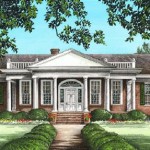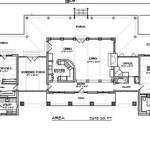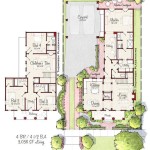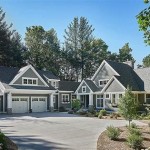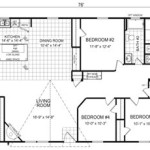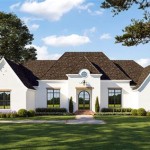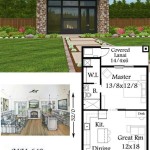Exploring the Timeless Appeal of Arts and Crafts Home Plans
The Arts and Crafts movement, a design philosophy that flourished from the late 19th century to the early 20th century, continues to exert a significant influence on residential architecture. Arts and Crafts home plans, characterized by their emphasis on craftsmanship, natural materials, and simple forms, offer a compelling alternative to more ornate and mass-produced styles. These homes prioritize functionality and a connection to the landscape, creating living spaces that are both aesthetically pleasing and deeply livable.
The resurgence of interest in Arts and Crafts architecture stems from a desire for authenticity and a rejection of contemporary design trends that often prioritize minimalism and technology over comfort and human connection. Arts and Crafts homes evoke a sense of warmth and permanence, serving as a refuge from the fast-paced and often impersonal nature of modern life. The enduring quality of these homes lies in their thoughtful design, high-quality construction, and timeless aesthetic.
Key Characteristics of Arts and Crafts Home Plans
Several defining features distinguish Arts and Crafts home plans from other architectural styles. These characteristics reflect the movement's core values of craftsmanship, simplicity, and harmony with nature. Understanding these elements is crucial for appreciating the unique appeal and lasting legacy of Arts and Crafts architecture.
One of the most prominent features is the emphasis on natural materials. Wood, stone, and brick are frequently used both inside and outside the home, showcasing their inherent beauty and texture. Exposed beams, hardwood floors, and stone fireplaces are common elements, creating a warm and inviting atmosphere. The use of natural materials extends to the exterior, with wood siding, shingle roofs, and stone foundations blending seamlessly with the surrounding landscape.
Simplicity of form is another hallmark of Arts and Crafts design. Homes typically feature clean lines, low-pitched roofs with wide eaves, and prominent porches. The overall design is unpretentious and functional, with an emphasis on creating comfortable and practical living spaces. Ornamentation is kept to a minimum, with details such as exposed rafter tails, decorative brackets, and handcrafted hardware adding subtle visual interest. The focus is on the quality of the materials and the craftsmanship of the construction, rather than elaborate embellishments.
A strong connection to the landscape is also essential. Arts and Crafts homes are often designed to blend seamlessly with their surroundings, using natural materials and colors that complement the environment. Large windows and doors provide ample natural light and ventilation, while porches and patios extend the living space outdoors. Gardens and landscaping are integral to the overall design, with native plants and natural features creating a harmonious relationship between the home and its setting.
Interior Design Elements in Arts and Crafts Homes
The interior of an Arts and Crafts home is as carefully considered as the exterior, with a focus on creating warm, inviting, and functional living spaces. The design principles of craftsmanship, simplicity, and natural materials are evident throughout the interior, creating a cohesive and harmonious aesthetic.
Open floor plans are common in Arts and Crafts homes, promoting a sense of spaciousness and facilitating social interaction. Living rooms, dining rooms, and kitchens often flow seamlessly into one another, creating a central gathering space for family and friends. Fireplaces are frequently a focal point of the living room, providing warmth and a sense of coziness. Built-in cabinetry, shelving, and seating are common features, maximizing storage space and adding to the overall functionality of the home.
Wood is a dominant material in Arts and Crafts interiors, with hardwood floors, wood paneling, and exposed beams creating a warm and inviting atmosphere. Natural finishes, such as stains and oils, are preferred over paints, allowing the natural beauty of the wood to shine through. Handcrafted details, such as carved wood trim, stained glass windows, and custom light fixtures, add a touch of artistry and individuality to the home.
Color palettes in Arts and Crafts interiors tend to be muted and natural, reflecting the colors of the surrounding landscape. Earth tones, such as browns, greens, and grays, are frequently used, creating a sense of calm and tranquility. Accent colors, such as warm reds, oranges, and yellows, can be used to add pops of color and visual interest. Textiles, such as wool rugs, linen curtains, and handcrafted pillows, add texture and warmth to the interior.
Adapting Arts and Crafts Home Plans for Modern Living
While Arts and Crafts home plans offer a timeless aesthetic and enduring appeal, they can be adapted to meet the needs of modern living. Incorporating contemporary amenities and technologies while preserving the core principles of the Arts and Crafts movement can create a home that is both beautiful and functional.
One key consideration is energy efficiency. Modern Arts and Crafts homes can incorporate energy-efficient windows, insulation, and heating and cooling systems to reduce energy consumption and lower utility bills. Solar panels can be integrated into the roof design, providing a sustainable source of energy without compromising the architectural integrity of the home. Smart home technology can also be incorporated, allowing homeowners to control lighting, temperature, and security systems remotely.
Another important aspect of adapting Arts and Crafts home plans for modern living is to consider the needs of contemporary families. Open floor plans can be modified to create more distinct living spaces, providing privacy and separation when needed. Kitchens can be designed with modern appliances and layouts, while still maintaining the warmth and charm of an Arts and Crafts style. Bathrooms can be updated with modern fixtures and finishes, while still incorporating natural materials and handcrafted details.
Accessibility is also an important consideration. Arts and Crafts homes can be designed to be accessible to people of all ages and abilities, with features such as wider doorways, ramps, and grab bars. Universal design principles can be incorporated into the overall design, creating a home that is both beautiful and functional for everyone.
By carefully considering these factors, it is possible to create an Arts and Crafts home that is both timeless and modern, offering the best of both worlds. The enduring appeal of Arts and Crafts architecture lies in its ability to create warm, inviting, and functional living spaces that are deeply connected to nature and rooted in craftsmanship. Adapting these principles for modern living ensures that Arts and Crafts homes will continue to be cherished for generations to come.

House Plans Arts And Crafts Art Bungalow Floor Craftsman

Bungalow Floor Plans Style Homes Arts And Crafts Bungalows Craftsman House

Art Crafts House With 4 Bedrooms Plan 161 1001

1908 Eclectic House Plan With Arts Crafts Detail Western Home Builder Design No 1 V W Voo Craftsman Style Plans Cottage Floor

Arts Crafts Bungalow House Plans The Red Cottage

Arts Crafts Home Plans Showcasing 85 In The Craftsman Prairie And Bungalow Styles Planners 9781931131261 Abebooks

2 Story Arts And Crafts Ranch House Plan 3 Bed 5 Bath

1922 Lewis Manufacturing Kit House Glenmere Arts And Crafts English Parallel Gables Craftsman Dream Plans Homes

Arts Crafts House Plan Floor Craftsman Home Homepatterns

Arts And Crafts Architecture

